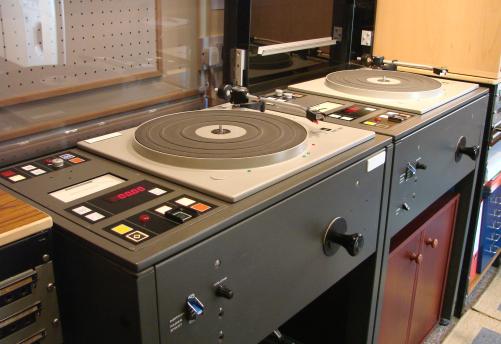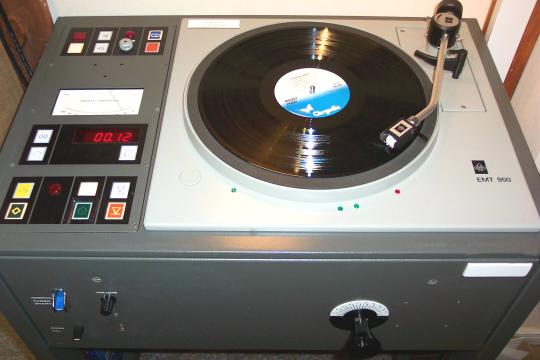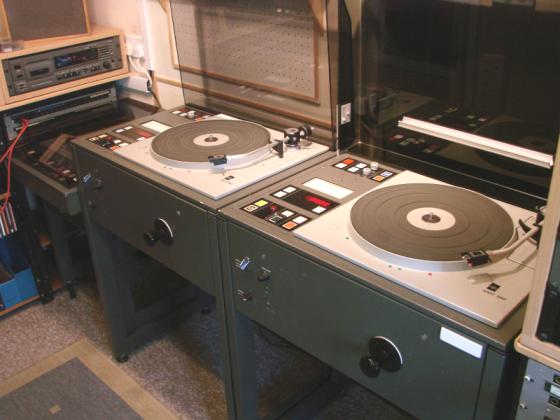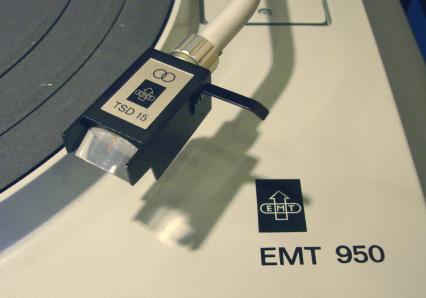EMT Professional Turntables
For the technically minded - here is some useful information about these wonderful machines! The EMT 950/347 was introduced in 1976 Built without any compromise in matters of cost, weight, size and aesthetics, it was introduced in two types, Standard', 950, (693 millimeters wide) with controls on the left side of the disc, and a Narrowline Model (950 E or Schmale Ausführung, 519 mm wide, 573 mm deep, introduced at the end of 1977) conceived for less spacious studios; the narrowline 950 had the same controls, but its pushbuttons were all lined up in the front panel. Starting time at 33 rpm was 200 milliseconds, and, just pushing a button, the record would rotate backwards to find the beginning of a track: the user could monitor the cueing with the inbuilt speaker. Both machines could be mounted on their own legs or in a console; the shock absorber frame was built-in. In stock form, whichever the cabinet, the 950 had three speeds (33, 45 and 78 rpm) with automatic selection of 33 or 45 at the raising of the central adapter for the smaller records, a 929 arm in stock aluminium finish with brass or black counterweight and a TSD15 Tondose with 4 150 056 transformers on the equalizer board 7 950 038 or 7 950 088 board 9 950 110 or narrow 9 950 210. It was possible to order a tailor-made 950 to suit any professional need, provided that the customer could pay the extremely high prices of this machine. In 1976, 15.000 Deutsche Marks was the basic list price of a 950.
The EMT "9 950 347", or, as it is more widely known, the 'BBC', was one of the final developments of the most formidable professional record player ever manufactured, the EMT 950. This impressive machine appeared in 1976 as a complete revolution in the conservative line-up of the Kippenheim firm: the legendary factory founded by Wilhelm Franz had traditionally based its success on the massive idler-wheel machines built since 1948 (EMT 927, 930) but with the death of the founder, in 1971, it had adopted a different strategy.
The new broadcast-quality EMTs, especially the flagship of the range, were based on an efficient direct-drive system and very complex electronics that allowed a very quick start-up time and braking, essential for cueing in radio environment. Sturdiness, stability and overall reliability were priorities of this futuristic machine; as money was no object, the end result was a 75-kgs monument to the technique of record reproducing. Built like a battleship, and painted in the same shade of medium grey, the 950 Schallplatten-Wiedergabe-Maschine' was and still is impressive. Its performance is shattering: wow, flutter and rumble were simply too low to be measured at the time, the start-up time of 200 m/sec was appropriate for broadcast cueing as was the possibility of turning the record backwards to the touch of a button to search for the desired cueing point. The superb 929 tonearm was a fitting complement to this formidable machine.
The 950 was undoubtedly way too complex and expensive for normal customers, but it enjoyed immediately a healthy success amongst the premium pro market, the "money-no-object' high spenders of the main broadcast corporations. RAI, SR, SDR, FR all bought their own versions of the 950; relatively few were the standard machines, most of the 950s being customized by the factory to the special order of the customer. The ultimate customization of the 950, though, arrived in the early Eighties with an order from the famed British Broadcasting Corporation. The BBC had used for years Garrard 301s and 401s, then the Technics SP-10, but the overall quality and operation facilities of the 950 made it the natural choice also for the mighty BBC. For reason we don't know, however, the British wanted some very special accessories for their machines, and this is where the history becomes quite interesting.
Much more interesting, and a real novelty about professional machines, is the zero locator. This is a sort of sophisticated digital chronograph connected to the start/stop/reverse functions of the 950. This digital time counter starts every time that the platter starts turning. It has a reset zero button that locates a desired cueing point and another button that uses the reverse of the 950 to take the platter automatically back to that cueing point (where the counter was reset). This is a very useful cueing tool. This is not all. The 347 also sports a Vario Control. This device, very rare on any 950 (after all, EMT guaranteed a perfect speed of its machines in any condition without any need for manual intervention), is useful to play discs recorded to non-standard speeds (like several early 78's). Should the need arise, the user can use this control on either coarse or fine level to obtain the desired playback speed. The only missing facility in this complex machine is the stylus illuminator, evidently deemed not so necessary by British engineers, but it can be installed anyway as a very useful extra. On the other hand, BBC found advantageous to fit several more controls on the front panel of the 347. On the same panel the 347 has a Penny & Giles potentiometer and two more switches: one normal-fader start that allows to start the record player from a mixer or from a local button; a normal-pfl switch that allows the user the monitoring of the program with a headphone (the level is controlled via a separate potentiometer); and an on/off switch for the built-in 950 muting.
The signal output of the 9 950 038 MM phono card (it is obviously possible to install the 088' card for Moving Coil cartridges), after the amplification in the preamp, is sent from the standard XLR connectors on the back of the 950 to the P&G potentiometer and then to a large proprietary connector situated under the deck. From this unusual connector the umbilical cord goes to the input of the studio mixer. The whole machine is protected by a large hinged Perspex cover thoughtfully incorporating a record-cover holder. Finally, the 347 sits 10 cms higher than the standard 950s, whose massive metallic legs are 73 cms tall (without the adjustable feet) whilst the British machines' are 83 cms tall. Weight of the 950 347 is nearly 76 kilograms. Written by Dr Stefano Pasini www.stefanopasini.it -------------------------------- Pictures by John Shaw (Shaw Sounds) © Copyright Shaw Sounds Transfer - Copy - Convert LP to CD | Vinyl to CD | 78 to CD | Tape to CD | Cassette to CD | DAT to CD
|
|
|
|
|
|












































